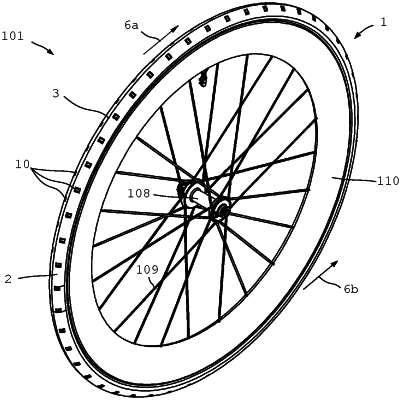| CPC B60C 3/04 (2013.01) [B60C 11/032 (2013.01); B60C 11/24 (2013.01); B60C 13/001 (2013.01); B60C 13/02 (2013.01); B60C 2200/12 (2013.01)] | 21 Claims |

|
1. A wheel component for at least partially muscle-powered sports and racing bicycles, comprising:
an annular tire and a tread surface configured in a central triangle segment and laterally adjacent side surfaces;
wherein the tread surface in proper use in straight-ahead travel on a plane ground makes at least partial contact with the surface of the ground, opening up a longitudinal sectional plane;
wherein aero elements are configured on the surface of the annular tire;
the aero elements are each configured planar as a depression in the surface of the tire and are disposed on the side surfaces; and define circumferential angular bands on the side surfaces;
wherein each circumferential angular band is defined radially inwardly and radially outwardly by the radial extension of the aero elements;
and that the surface proportion of the aero elements to the surface of an angular band is more than 5% and less than 25%,
and wherein each aero element is configured separately on the surface and wherein a distance from each said aero element to the next said aero element is larger than the maximum dimension of the aero element;
wherein the surface of the circumferential angular band is configured without profile, except for said aero elements;
wherein the surface proportion of the aero elements to the surface of the tire that is visible in proper use, is on the whole more than 2% and less than 8%, and wherein each aero element comprises between 0.01% and 0.1% of the surface of the tire visible in proper use.
|